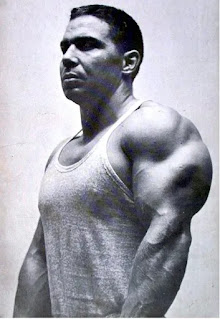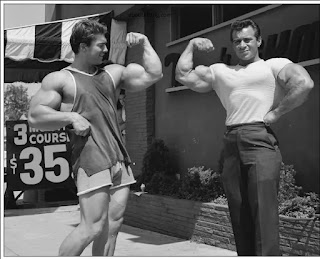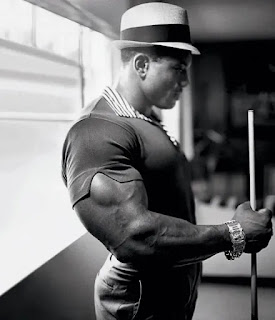Bill Pearl (above) circa 1966: his relaxed arm looked better than his flexed arm, which were a bit anticlimactic. This photo made me redouble my tricep work.
In 1962 I was 12 years old. I found a 5-pound solid dumbbell in the yard next door to my grandmother’s East Arkansas truck farm. I decided that I would do sets of bicep curls every couple of hours, from dawn to dusk. I likely did 500 cumulative curls for each arm with the five pound dumbbell that day. The next day I awoke with involuntarily contracted biceps: both my biceps were frozen, contracted, unable to relax. My hands were next to my shoulders and face, I could not straighten my arms more than four inches without excruciating pain. My 80-year-old grandmother was baffled by my condition and my explanation.
My younger brother and my cousin Joey quickly figured out that I was helpless as a trussed chicken. They would gleefully sneak up, leap out, and pull down on my frozen arms like slot machine handles. The pain jolt would cause me to yelp and spastically scramble away, tripping over things in my haste to escape. The sensation was akin to being hooked up to car battery and repeatedly shocked by torturers. No doctors or sympathy for Marty.
Ride it out. I would flee my tormenters, running away when I detected a sneak attack. Running frantically with hands frozen next to my face made me look like a crazed ostrich. They laughed when they inflicted the pain and they laughed when I ran away. It took three days for my arms to normalize. I then instituted a reign of terror; it was retribution and payback time. I also learned a valuable lesson about overtraining.
I have trained my arms my whole life. That is a bit of an exaggeration. I started at age 11. My earliest idealized male role models were mythological gods and comic book heroes: all of them had outstanding physiques and outstanding arms: Zeus, Hercules, Jupiter, Apollo, Odin, Thor, Batman, Superman, Green Lantern, Aqua Man, Flash, even Robin had a great physique with sculpted muscles and good arms.
I started reading the muscle mags, Strength & Health (Hoffman, York,) Muscle Builder (Weider Bros. SoCal) and Iron Man (Peary Radar, Nebraska) in 1962. My earliest muscle mag big arm heroes were Reg Park with his baseball biceps, Bill Pearl for his incredible relaxed arms, Freddy Ortiz’s freaky peaked biceps, Larry Scott’s great flexed biceps, Leroy Colbert’s incredible baseball bicep, and Sergio Oliva with his ham-hock 20-inch arms that had no peak. All this before Arnold took over with his incredible peaked biceps in the 1970s.
What have I learned training arms for sixty years? First off, if you want big arms, you must train them, biceps and triceps, on a regular and repeated basis. Secondly, you need to understand that there is an exercise hierarchy amongst arm exercises: not all arm exercises are created equal, some are indispensable, and some are superfluous. Thirdly, there is an undeniable correlation between arm size and bodyweight: to grow big arms you must be prepared to add quality bodyweight.
A 150-pound man with 15-inch arms will never develop 17-inch arms, much less 18-inch arms, staying at a 150-pound bodyweight. This inconvenient truth, to grow larger arms requires adding bodyweight, is ignored by arm training fanatics. It makes no sense to spend an inordinate amount of time training for big arms unless the arm work is done in conjunction with a mass-building (calorie-surplus) phase. Without being in a caloric-surplus condition, no increase in arm size will occur. Ergo, any arm work done, is, at best, maintenance.
The way to improve arm size is to train the hell out of your arms while eating copious clean calories and slowly, methodically, add quality bodyweight. The Arnold-era rule of the thumb was: to increase arm size by one inch a man needed to add ten pounds of lean muscle mass. Lean muscle mass is not marbled with an unacceptable amount of body fat.
Arm Gods 1964: Freddy Ortiz and Larry Scott (above) stand in front of Vince Gironda’s Hollywood Gym. Freddy had 19-inch arms and a 29-inch waist.
What is the sense of adding ten pounds of muscle if it is accompanied by ten pounds of body fat? If the arm-builder has a terrible diet, if he takes in additional calories needed to fuel and trigger growth from “dirty” calories, i.e., calories derived from pizza, beer, ice cream, pie and donuts – then guess what? weight gain will contain an unacceptable amount of body fat. No kidding.
The smart way to get big arms is – first, lean out, clean up the diet. The overweight and out-of-shape need to first lean out and tighten up. Get fit first. After a protracted (10-12 weeks) lean-out phase, the now fit trainee has earned the right to go on a mass-building regimen - coupled with a body part specialization program, in this case, an arm specialization program.
This ancient strategy, specialize, slam quality calories, is designed to add a full inch to a man’s arm in 10-12-weeks. This needs to be accompanied with a ten-pound increase in lean muscle mass. This specialization strategy (in this case, arm-building) strategy has been used since the 1950s. Train the targeted lagging muscle like your life depended on it: slam protein and fiber and quality starch carbs. Nudge the scale upward one pound at a time, no more, no less.
When I trained under world powerlifting champion Hugh Cassidy, he always had us finish every workout with bicep/tricep work. “Might as well look the part.” He would say. He and I saw Bill Pearl at a York Barbell picnic in 1968. Hugh, already a stud, was impressed. “That Bill Pearl, he sure looked great when he was walking around the York picnic in a tee-shirt.” Pearl’s relaxed triceps looked like a mixed sack of bowling balls, baseballs and golf balls. Hugh had a similar reaction years later when we met Roger Estep. “Did you see the way his arms and forearms rippled as he ate that apple?!”
The smart trainee leans out, i.e., reduces body fat, becomes as fit as possible before embarking on a mass-building/arm specialization program. Asking an individual eating a bad diet to add size is an express train to a 20% + body fat percentile and an inability to walk up ten flights of stairs in an emergency without risking a heart attack. No bulking up for the already overweight and out-of-shape. You must earn the right to embark on a mass-building phase, one done in conjunction with a body part specialization program.
Anytime that the goal is to bring up a lagging body part, the goal is to increase muscle size. How can you increase a muscle’s size and not add bodyweight? How can you add bodyweight if you do not take in a surplus of nutrients? You need eat enough, drink enough, to support the body-shattering resistance training that it takes to bring up an undersized, weak body part. If the additional nutrients are clean fuel, if cardio is done, weight gain will be predominately muscle. The good news is that lagging body parts subjected to effective training and appropriate nutrition respond quickly. The optimal mass-building phase is preceded by a highly successfully lean out phase. What do you do when it is time to pull the trigger on an Old School commonsense arm specialization training program?
Sergio Oliva (above), 1966: is having arms bigger than your head disproportional? Seeing this photo made me redouble my already redoubled tricep work
Programing
Optimally, when specializing, the arms are trained twice weekly, at opposite ends of the training week. Here is a classical power-bodybuilding arm training split: the arms are trained twice weekly with a different training menu in each weekly session…
| Monday | Tuesday | Wednesday | Thursday | Friday | Saturday | Sunday | |
| Arms | x | Off | x | Off | Off | ||
| Chest | x | Off | Off | Off | |||
| Back | Off | x | Off | Off | |||
| Shoulders | Off | x | Off | Off | |||
| Legs | x | Off | Off | Off |
Tuesday Arm Exercises:
- Standing barbell cheat curl
- Dips
- Seated dumbbell curls
- Single overhead dumbbell tricep press
- Preacher curl
- Tricep pushdowns
Friday Arm Exercises:
- Steep incline dumbbell curls
- Nose-breakers w/EZ curl bar
- 90-degree spider curls (or single-dumbbell concentration curls)
- Overhead French press on Smith machine
- Cable curls
- Cable pushdowns using rope handles
- Biceps and triceps are super-setted, alternated: set of biceps, set of triceps, rest, repeat
- Make the mind/muscle connection: poundage is unimportant; go for feel and contraction
- 3-4-5 sets per exercise: add poundage each set; one or two ‘top sets’ (stronger trainees need more sets)
- Barbell-dumbbell exercises, keep reps in the 5-8 rep range
- Dips are done both weighted and unweighted
- Cable exercise reps are in the 8-12 rep range, continuous tension
- Exercises can and should be switched out every 4-6 weeks
*The fit athlete seeks to add one pound of bodyweight per week for ten straight weeks: ten pounds = one additional inch of arm size. That is what we seek: one full inch added to arm size in 10-weeks, 70-days of concentrated effort.
- Each successive week, the slightly larger athlete squeezes out another rep or two or three, or they increase the poundage used ever so slightly without any degradation in the form.
- Each successive week the adaptive response is continually triggered; progress is coaxed. Small weekly gains deposit the trainee at the predetermined destination. The goal is a significant increase in arm size.
- Precision nutrition refuels and heals the workout-battered muscles. The fit athlete makes expert use of regular food to create an anabolic environment. Anabolism is established by a surplus of calories.
- Train arms after chest training on day 1. Train arms again, using different exercises, 2-3 days later after blasting shoulders. Each session stresses technique and making the mind/muscle connection.
A “window of opportunity” opens after an intense training session. If quality nutrients are ingested while the window is open, nutrients are digested and distributed at triple the normal speed. Take advantage and smart bomb with some sort of replenishment after crushing yourself in a high intensity resistance training session. Building bigger arms requires a comprehensive approach. Without combining incredibly intense arm training with a surplus of nutrients, the right kind of nutrients, clean calories, the best you can hope for is to maintain whatever you have built. When it comes to adding arm size, you need to revisit the Old School ways: first, get fit, earn the right to specialize. Add quality bodyweight slowly and methodically; train your arms like your life depended on it, hold the course for three months. Building bigger arms is the ultimate in Old School sophisticated simplicity.



Comments
Post a Comment